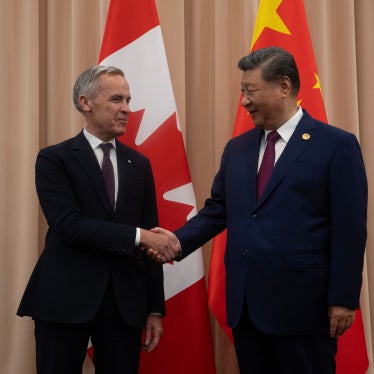Human Rights Watch said that China's new "White Paper" on human rights is clearly aimed at the ongoing session of the U.N. Commission on Human Rights in Geneva -- part of the same lobbying strategy that brought Jiang Zemin to Latin America.
"This so-called White Paper is a whitewash of China's human rights practices," said Sidney Jones, Asia director of Human Rights Watch. "But we've seen this combination before: high-level visits to Latin American to get allies for the Commission, together with the release of a report which boasts that China's human rights record has never been better."
The current session of the U.N. Human Rights Commission opened on March 19; China's rights record is expected to be discussed later this month.
The new White Paper, issued by Beijing Monday, highlights:
improvements in the general standard of living and in "people's rights to subsistence and development" at a time when the collapse of rural education and healthcare programs has been of growing concern.
the guarantee of citizens' political rights, at a time when controls on freedom of association, assembly, and expression, already tight, are tightening further. The recent arrests of Chinese scholars resident abroad and Falun Gong members are a case in point.
China's efforts to ensure an impartial judiciary, when the politicization and party control of the courts is a constant of the Chinese legal system.
protection of women and children's rights, after a much publicized explosion in a school in Jiangxi province where children were illegally making firecrackers caused the deaths of 41 people.
equal rights and special protection for ethnic minorities at a time when efforts to establish schools for Uighur children led to the arrest of a prominent Uighur businesswoman, and Tibetan cultural institutions are under constant surveillance from state authorities.
China's "positive attitude toward carrying out international cooperation in human rights" at a time when it systematically flouts some of the most important provisions of the human rights treaties it has ratified (e.g. the International Covenant on Economic, Social, and Cultural Rights) and signed (the International Covenant on Political and Civil Rights).
The first Chinese White Paper on Human Rights was published in November 1991, while the memories of Tiananmen Square were still fresh, and pressure was building toward a resolution on China at the 1992 Commission. Another White Paper was published in March 1997, reviewing China's human rights achievements in 1996, and another in February 1998.
There is also a precedent for high-level visits to Latin America just before the Commission. Of the six countries on President Jiang Zemin's current itinerary -- Chile, Argentina, Uruguay, Brazil, Cuba, and Venezuela -- all but Chile are members of the current Commission. Some of these countries might be inclined to join with the United States, if not in sponsoring a resolution, then in trying to defeat China's efforts to ensure it will not come to a vote. In late 1995, with a view to the 1996 Commission session, senior Chinese officials embarked on a series of high-level exchanges with Latin American leaders, and then Premier Li Peng went to Peru and Mexico. Before the 1997 Commission, Li Peng visited two key Commission countries, Brazil and Chile, and China's senior trade official, Wu Yi, visited six Latin American countries, all but one of which were to be members of the 1997 Commission.







